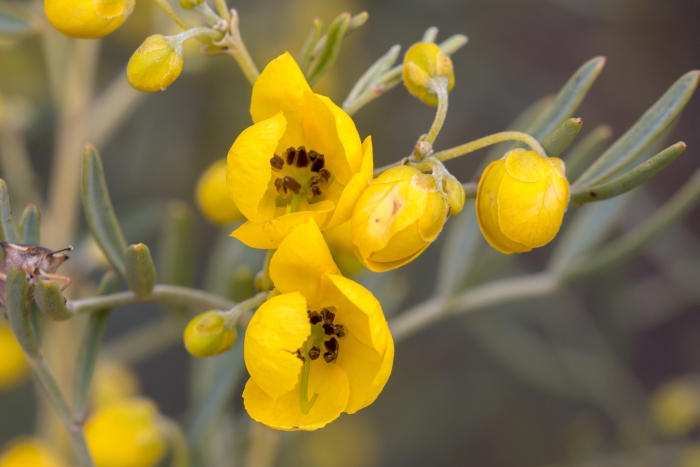Wormwood Senna
(Senna artemisioides)
Wormwood Senna (Senna artemisioides)
/
/

Andrew Allen
CC BY 4.0
Image By:
Andrew Allen
Recorded By:
Copyright:
CC BY 4.0
Copyright Notice:
Photo by: Andrew Allen | License Type: CC BY 4.0 | License URL: http://creativecommons.org/licenses/by/4.0/ | Rights Holder: Andrew Allen | Publisher: iNaturalist | Date Created: 2019-09-08T08:04Z |


















































Estimated Native Range
Summary
Senna artemisioides, commonly known as Wormwood Senna, is an evergreen shrub native to the arid regions of Australia, including deserts and dry scrublands. It typically grows up to 3 meters (9.8 feet) in height and has a rounded form. The grey-green pinnate leaves consist of 1 to 8 pairs of leaflets, which contribute to its feathery appearance. Wormwood Senna is notable for its abundant yellow "pea" flowers, about 1.5 cm in diameter, that bloom in winter and spring, providing a splash of color during these seasons. The flowers are followed by 2 to 7 cm long flat green pods that mature to dark brown.
Wormwood Senna is valued for its drought tolerance and ability to thrive in harsh conditions, making it a suitable choice for xeriscaping and low-water gardens. It is also recognized for its ornamental qualities, such as the bright yellow flowers that contrast beautifully with the grey-green foliage. This plant is often used in rock gardens, as a border shrub, or in naturalistic plantings. It requires minimal maintenance once established and is propagated readily from seed, which should be treated with boiling water to break dormancy. Wormwood Senna has earned the Royal Horticultural Society’s Award of Garden Merit, indicating its exceptional performance in gardens. It is best grown in full sun to part shade and prefers soils with medium drainage. While it adapts to a wide range of climatic conditions, it is susceptible to frost, especially when young, and should be protected or planted in frost-free areas.CC BY-SA 4.0
Wormwood Senna is valued for its drought tolerance and ability to thrive in harsh conditions, making it a suitable choice for xeriscaping and low-water gardens. It is also recognized for its ornamental qualities, such as the bright yellow flowers that contrast beautifully with the grey-green foliage. This plant is often used in rock gardens, as a border shrub, or in naturalistic plantings. It requires minimal maintenance once established and is propagated readily from seed, which should be treated with boiling water to break dormancy. Wormwood Senna has earned the Royal Horticultural Society’s Award of Garden Merit, indicating its exceptional performance in gardens. It is best grown in full sun to part shade and prefers soils with medium drainage. While it adapts to a wide range of climatic conditions, it is susceptible to frost, especially when young, and should be protected or planted in frost-free areas.CC BY-SA 4.0
Plant Description
- Plant Type: Shrub
- Height: 3-5 feet
- Width: 3-5 feet
- Growth Rate: Rapid
- Flower Color: Yellow
- Flowering Season: Winter, Spring
- Leaf Retention: Evergreen
Growth Requirements
- Sun: Full Sun, Part Shade
- Water: Low
- Drainage: Medium
Common Uses
Bank Stabilization, Bee Garden, Bird Garden, Butterfly Garden, Fragrant, Low Maintenance, Rabbit Resistant, Salt Tolerant, Showy Flowers, Street Planting
Natural Habitat
Arid regions of Australia, including deserts and dry scrublands
Other Names
Common Names: Silver Senna, Silver Cassia, Feathery Cassia, Leafless Cassia, Silverbush, Woody Cassia, Grey Cassia, Puntybush
Scientific Names: , Senna artemisioides, Cassia nemophila, Cassia artemisioides, Cassia nemophila var. nemophila, Cassia teretifolia, Cassia artemisiifolia, Cassia artemisioides var. eremophila, Cassia glaucescens, Cassia teretiuscula,
GBIF Accepted Name: Senna artemisioides (Gaudich. ex DC.) Randell